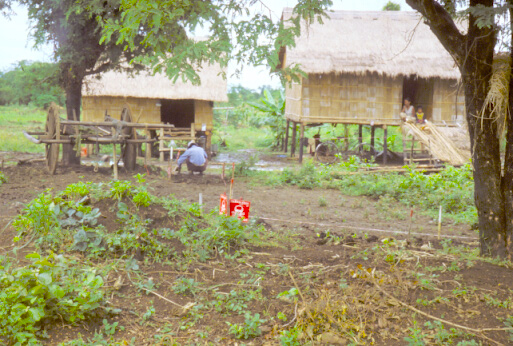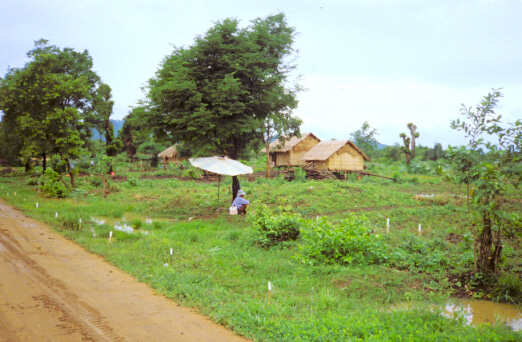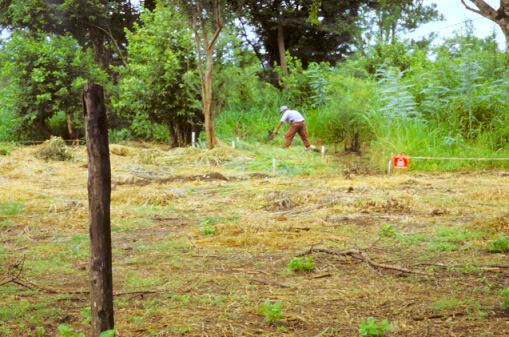|
Landmines in Cambodia Readings: The most up-to-date readings on this issue are reports on the Internet: https://www.camnet.com.kh/cambodia.daily/Land_Mine/situation https://www.bigpond.com.kh/users/ngoforum/Woking_Group_Issues/Landmines/final_report (note that Woking is as in the original) Cambodia is one of the most heavily mined areas in the world; some estimates run as high as ten million mines (in a country of 11.5 million people), though the Cambodian Mine Action Center (CMAC) estimates 4 to 6 million mines. Cambodia is also littered with other kinds of unexploded ordinance (UXO), left over from half a million tons of bombs dropped on Cambodia by the United States in the late 60s and early 70s. The figures here are not known, though there is an estimated "dud" rate of 10 percent for UXO (Cambodia Daily website). There are many different kinds of bombs and mines: US material from the "Vietnam" war era, and Chinese, Soviet and eastern block made materials left from the Khmer Rouge era in the 1970s and a decade of civil war that followed in the 1980s. For a list of types of mines see: https://angola.npaid.org/minelist_complete_cambodia.htm If you are a tourist using this website to decide whether or not to visit Cambodia, you should know that mines are a problem today only in certain areas of the country. A recent survey by NGOs found that 70 percent of all casualties were in the northwest, with half in just 20 districts (Cambodia Daily website). The area around Angkor Wat and the central plains near Phnom Penh have already been cleared. This said, it is always wise to talk to local people before going off for a walk in remote areas, particularly forested areas. Cambodia is not yet a country where backpacking in the mountains is a good idea. Sticking to the normal tourist circuits is fine, but if you want to rent a motorcycle and ride the back roads of Siem Reap or Battambang provinces you must ask about mine safety first. Similarly, if one wants to cross the border from Thailand anywhere but the open crossing points on main roadways, then you need to consult with local people about particular pathways. This legacy of three decades of war had taken a severe toll on the Cambodia people; some 40,000 people live as amputees, one of the highest rates in the world. But at least that number again must have died in remote areas before they could be transported to medical facilities, before they were discovered, or because of infections. Because of the lack of a working medical system throughout the country, many Cambodian amputees have had multiple surgeries, one at the time of the initial injury, but others later when infections could not be contained. Mine injuries are more fatal among children, and those children who do are more likely to be seriously injured (UNICEF website). The costs of laying mines are low, as little as $3 US per mine, but the costs of removal are very high, $1000 US per mine or more. One study, cited on a UN website, noted a particular project in Cambodia where 45 deminers worked seven months. They found 265 mines and 943 units of unexploded ordinance. The cost of the project was about $378,000 US, or about $1,400 US a mine or $5 US for every square meter of cleared land. About one third of this money went for international salaries and benefits, 27 percent for radios, computers and other equipment, and 20 percent for metal detectors. Only about 4.5 percent went for local salaries, and 8 percent for local administration (See: www.ncrb.unac.org/landmines/UNAinfo/landmine-removal.html ). The story of landmine removal in Cambodia is, however, as one deminer says, "not a story of gloom and doom. It is a story of success" (Cambodia Daily website). There are three main organizations working to clear landmines in Cambodia: the Cambodia Mine Action Committee (CMAC), the Mines Advisory Group (MAG) and the Halo Trust. Between 1993 and 1999 the three groups cleared 66,027,761 square meters, or 66 square kilometers. Each year they have been clearing faster than the year before. In 1999, the three groups combined cleared 11,857,920 square meters, with CMAC, the government body that also coordinates all demining, clearing 9,573,821 square meters (NGO forum website). Most importantly the number of mine casualties is falling. The numbers of new injuries dropped by half from 1996 to 1997 when the number was 1,369. In 1999 the number had fallen further, to about 1,200, and in 2000 to about 50 per month (Cambodia Daily, NGO forum and UNDP websites). The high casualty spots are becoming increasingly localized, as certain areas are cleared and no new landmines are laid. While I could find no statistics on casualties in the last two years, there has been no fighting in Cambodia since 1999 when the last Khmer Rouge units defected to the government. In that same year, Cambodia ratified the Mine Ban Treaty and since then no new mines are being laid. Now clinics are increasingly making prosthetics for victims of polio and other diseases, as more than half of their total clients are now not landmine victims. Those who are still being injured know that the areas where they travel and work are mined. The leading cause of landmine injuries, according to the NGO forum report is poverty. Thirty-eight percent of injuries result from people tampering with ordinance, usually to try to get the scrap metal to sell. Fifty-six percent of injuries occur when people are trying to earn a living; farming, carrying water, collecting wood, collecting forest products, and so on. As the war of the last three decades has ended, people have returned from refugee camps along the border with Thailand, from service in the military, and from being internally displaced within the country. There is not enough land for everyone, so people are willing to risk living and farming in areas that are being demined in order to stake their claim to some bit of land (see photos). The pictures below show demining near peoples' homes on the road to Pailin (c. 2000)
It was issues of landownership in demined areas that sparked controversy surrounding the work of CMAC. In 2000 these issues came to the fore as funders demanded accountability on which projects were receiving priority for demining and who was benefiting from CMAC activities. In response to funders’ budget cuts, CMAC temporarily cut back on their activities. According to the CMAC website they had 67 demining platoons in the field in October 2000 before the layoffs. In January 2001 they had only 15, but had built back up to 46 teams by the end of 2001. Even with these reductions in 2001, they were able to clear 8,338,063 square meters of land. None of the websites discuss the problems within CMAC in detail; they refer instead to changes that have been made since the crisis in confidence (for more see Phnom Penh Post July 23-August 5, 1999; February 18-March 2, 2000; and April 28-May 11, 2000). The Cambodian government set up a new Cambodian Mine Action and Victim Assistance Authority to coordinate and regulate the demining sector, including national and international service providers. CMAC also set up new "mobile platoons" that could respond more immediately and flexibly in remote areas. Once some changes had been made in oversight and process, it seems that funding was restored to near pre-crisis levels (see UNDP and CMAC websites). Of the material available on line on this topic, two issues might be of particular interest for students. Some of the sites have the stories of individuals who work as deminers (see for example: www.camnet.com.kh/cambodia.daily/Land_Mine/page_18.htm). These deminers include Khmer injured by mines and women widowed by mine explosions. Second, there is some material at the CMAC, MAG, and Cambodia Daily websites about demining technologies. While much of the work of demining is done lying flat on one’s belly delicately probing the ground in front of one with a metal probe, other kinds of technologies are being used in Cambodia. These include metal detectors and mine sniffing dogs. One of the newest advances is mechanical brushcutters. Deminers spend some 70 percent of their time cutting vegetation in an effort to sweep the earth below. If machines can be used to clear the vegetation from the "lane" they are clearing, deminers can operate much faster and more efficiently, perhaps twice as fast. The problem of landmines in Cambodia is one with an optimistic long-term outlook. New mines are no longer being laid and the number of new injuries is declining dramatically. Still, the issue will remain central to understanding Cambodian society for some time. The poorest of the poor will continue to risk their lives to live in areas not yet cleared. The process of removing the landmines that remain could take ten years, and the remaining unexploded ordinance longer than that. Those clinics that produce and fit prosthetics will continue to serve Cambodians, including those disabled by disease, those previously injured and not yet fitted, and those who already have prosthetics. The devices need to be repaired or replaced as they wear and as the person ages. And Cambodian society must address the issue of those disabled by mines. Traditionally in Khmer society the person was viewed as unlucky, their own bad karma having sentenced them to a life of misery. It was assumed, furthermore, that those with only one leg or one arm could not be productive members of society (see French 1994). These attitudes have changed somewhat during the 1980s and 90s as men (and some women) returned from the battlefields and took up jobs. The government provided only miniscule military benefits to amputees. In the late 1980s, groups of amputees would band together in armed groups and block roadways, demanding money to allow travelers to pass. Today some can be found begging around the central markets of the city, but many more have found work at a wide range of jobs. Links on this topic: https://www.camnet.com.kh/cmac/ https://www.un.org.kh/undp/prog-man.html https://angola.npaid.org/minelist_complete_cambodia.htm (complete list of landmines found in Cambodia) https://www.camnet.com.kh/cambodia.daily/Land_Mine/land_mines.htm (click on the picture) https://www.camnet.com.kh/cambodia.daily/Land_Mine/mines.htm https://www.ncrb.unac.org/landmines/UNACinfo/landmine-removal.html (Costs of mine removal) https://maic.jmu.edu/journal/4.3/focus/Cambodian_MAC/camb_mac.htm https://www.unops.org.my/project/cambodia/cmac.htm https://www.mineaction.org/countries/countries_overview.cfm?country_id=Cambodia https://mag.nmnp.org/02/25/ (Daily report from Mine Advisory Group in Cambodia) |


